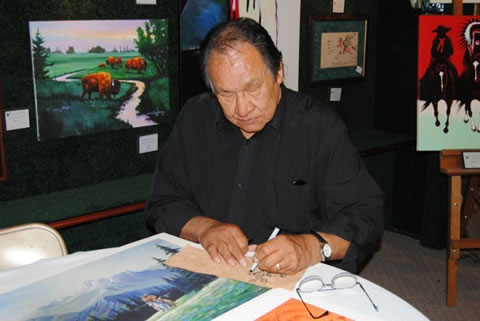 |
Canku Ota
|
 |
|
(Many Paths)
|
||
|
An Online Newsletter
Celebrating Native America
|
||
|
August
1, 2011 - Volume 9 Number 8
|
||
|
|
||
|
Long Soldier’s
Paintings Tell Native American Stories
|
||
|
by Jennifer Cleveland
Record rapidcityjournal.com/
|
||
|
credits: photo by Jennifer
Cleveland
|
|
Long Soldier, of the Oglala Sioux, was born near Potato Creek on the Pine Ridge Reservation into a family of 12 children. He started drawing with sticks on the sandbars of a local creek when he was about five years old. Long Soldier said he attended reservation boarding school from age six to 16 and was away from his family for most of his school life. School was difficult for Long Soldier because he couldn’t speak English, so he spent most of his time doodling. It took a long time for him to learn to speak English, and he said that he is still learning. Long Soldier said he remembers spending his lunch time at school drawing while the other children played. By the fifth grade, Long Soldier said he was painting murals for school projects and began experimenting with different mediums. Growing up on a ranch south of Rushville taught Long Solider a lot about ranch life and being around his relatives also taught him much of what he knows about his culture and language, Long Soldier said. Not too long ago, Long Soldier said, he took his wife, Robin, and two children, Cody and Kieli, to his old ranch house in Rushville to show them where he grew up. Long Soldier said he was surprised to see that his wall drawings were still there. Long Soldier, who has been painting what he calls Lakota Wicitowa (Lakota paintings) for over 30 years, works mostly with pen and ink and Gouache, which he explained as a water based paint that is a medium between water color and acrylic. A self-taught artist, Long Soldier paints various Native American related subjects, such as scenery, still life, animals, pictographs or anything that he sees or what comes to mind. Inspiration for his paintings comes not only from his relative’s stories, but from when he worked at the nursing home in Pine Ridge in the 1960s. Long Soldier said that during this time, many Native Americans who could speak Lakota were hired at the nursing home to communicate with the elders. Long Soldier said that he heard many stories from the elders in the nursing home and that many of them were descendents of famous Native Americans, such Ben Black Elk and those involved in the battle of Little Big Horn. Long Soldier’s wife, Robin, who is also native, grew up in a military back ground and said that she didn’t know much about the Native American culture until she met her husband. Robin said that through her husband and his art work, she has learned a lot about Native American traditions. She said that there is “no way that anyone could look at his (Long Soldier’s) paintings and not learn from them.” Long Soldier, who lives in Gordon, has art work all over the United States and in other countries, such as Germany, Japan, Europe, Italy and Finland. He has recently been signed with Greenwich Workshop, a major publisher of fine art. He has also worked with artists like Tom Gilleon to help depict Native American culture. He painted the pictographs on the teepees in Gilleon’s painting titled “Soldiers Falling into Camp.” Long Soldier’s paintings are available for viewing at the Silver Eagle Gallery located at 261 Main Street in Chadron. |
|
|
||
|
|
||
| Canku Ota is a free Newsletter celebrating Native America, its traditions and accomplishments . We do not provide subscriber or visitor names to anyone. Some articles presented in Canku Ota may contain copyright material. We have received appropriate permissions for republishing any articles. Material appearing here is distributed without profit or monetary gain to those who have expressed an interest. This is in accordance with Title 17 U.S.C. Section 107. | ||
|
Canku Ota is a copyright ©
2000, 2001, 2002, 2003, 2004, 2005, 2006, 2007, 2008, 2009, 2010,
2011 of Vicki Barry and Paul Barry.
|
||
 |
 |
|
|
The "Canku
Ota - A Newsletter Celebrating Native America" web site and
its design is the
|
||
|
Copyright ©
1999, 2000, 2001, 2002, 2003, 2004, 2005,
2006, 2007, 2008, 2009, 2010, 2011
of Paul C. Barry.
|
||
|
All Rights Reserved.
|
||
 Keeping
his culture alive and telling the stories of Native American traditions
and history through his artwork has been the main drive in Daniel
Long Soldier’s art career.
Keeping
his culture alive and telling the stories of Native American traditions
and history through his artwork has been the main drive in Daniel
Long Soldier’s art career.